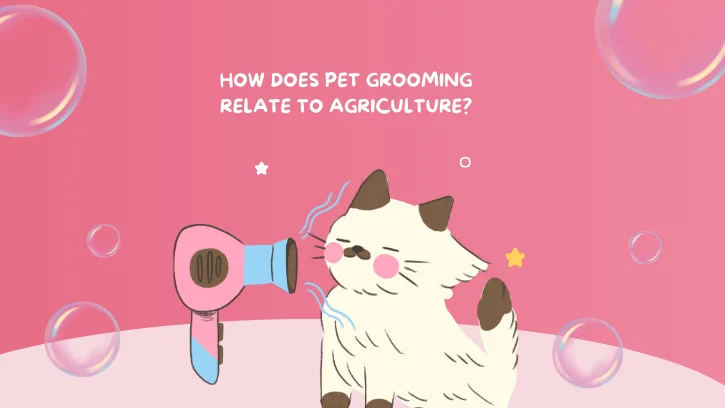How Does Pet Grooming Relate to Agriculture? This question uncovers a fascinating intersection between two seemingly different fields. Both pet grooming and agriculture prioritize animal welfare, using similar techniques to maintain the health and hygiene of animals. Agricultural practices such as shearing sheep have parallels in grooming certain dog breeds, showcasing the shared skills and tools. Economically, agriculture supplies raw materials like lanolin for pet grooming products, creating a symbiotic relationship.
Furthermore, educational programs in veterinary sciences often integrate grooming practices for both livestock and pets, ensuring comprehensive animal care training. Understanding how pet grooming relates to agriculture highlights the mutual benefits and cultural significance within rural communities. These connections not only enhance animal well-being but also support the livelihoods of those involved in both sectors. Exploring this relationship deepens our appreciation of the intricate ties between pet grooming and agriculture.
Pet grooming and agriculture might seem like two distinct fields, but they share several connections that intertwine their practices and principles. Both sectors play crucial roles in animal welfare, economic activities, and community well-being. Understanding the relationship between pet grooming and agriculture can provide insights into their mutual benefits and the ways they complement each other.
The Role of Animal Husbandry in Agriculture
Animal husbandry is a fundamental component of agriculture, involving the breeding, care, and management of livestock. Proper grooming is essential in maintaining the health and productivity of farm animals. Clean and well-groomed animals are less susceptible to diseases, infections, and parasites, which can affect their growth and milk production. Routine grooming practices, such as shearing, hoof trimming, and deworming, are crucial for the overall well-being of farm animals.
Pet Grooming Techniques Derived from Agricultural Practices
Many pet grooming techniques have roots in agricultural practices. For instance, shearing sheep has parallels with trimming the coats of certain dog breeds. The skills and tools used in grooming farm animals often translate to pet grooming. Clippers, brushes, and combs used for livestock grooming are adapted for pets, ensuring they receive the same level of care and hygiene.
Economic Interdependencies
The economic interdependencies between pet grooming and agriculture are significant. Agricultural by-products, such as lanolin from sheep’s wool, are often used in pet grooming products. This creates a symbiotic relationship where agriculture supplies raw materials for pet care industries. Additionally, farmers who also breed pets benefit economically from grooming services, enhancing the value of their animals and making them more appealing to potential buyers.
Pet Grooming and Livestock Shows
Livestock shows and fairs highlight the intersection of pet grooming and agriculture. Animals showcased in these events are groomed meticulously to present their best features. This grooming not only improves the animal’s appearance but also ensures they meet specific breed standards. The skills honed in grooming for these shows are often applied to pet grooming, enhancing the techniques and standards within the pet grooming industry.
Animal Welfare and Health
Both pet grooming and agriculture prioritize animal welfare and health. Regular grooming helps in early detection of health issues such as skin infections, parasites, and abnormalities. This proactive approach is essential in agriculture, where the health of livestock directly impacts productivity and profitability. Similarly, pet grooming ensures that pets remain healthy and comfortable, reducing the likelihood of health problems.
Environmental Considerations
Sustainable practices in agriculture often influence pet grooming. For example, organic farming practices that avoid harmful chemicals can extend to the production of natural and eco-friendly pet grooming products. This promotes a healthier environment for both farm animals and pets. Additionally, responsible waste management practices in agriculture can inspire similar approaches in pet grooming businesses.
Educational and Training Overlaps
Educational programs and training in animal care often cover both agricultural and pet grooming aspects. Veterinary courses, for instance, include modules on grooming for both farm animals and pets. This integrated approach ensures that professionals are well-versed in maintaining the health and hygiene of a wide range of animals, benefiting both sectors.
Innovations and Technological Advances
Technological advancements in agriculture often find applications in pet grooming. Innovations such as automated shearing machines and advanced grooming tools initially designed for livestock are adapted for pet use. This cross-application of technology enhances efficiency and quality in pet grooming, providing better care for pets and making grooming processes more streamlined and effective.
Community and Cultural Significance
In many rural communities, the practices of agriculture and pet grooming are intertwined culturally and socially. Farmers often raise pets alongside their livestock, and the care given to these animals is reflective of broader agricultural practices. Community events, such as agricultural fairs, often feature pet grooming contests, highlighting the cultural significance of grooming in rural life.
Conclusion
The relationship between pet grooming and agriculture is multifaceted and deeply intertwined. Both fields contribute significantly to animal welfare, economic activities, and community life. By understanding their connections, we can appreciate the mutual benefits and the ways in which they complement each other. From shared techniques and tools to economic interdependencies and cultural significance, pet grooming and agriculture together enhance the well-being of animals and the livelihoods of those who care for them.
Q&A Section
Q1: How do agricultural practices influence pet grooming techniques?
A1: Agricultural practices influence pet grooming techniques through the adaptation of tools and skills used in livestock grooming. Techniques such as shearing sheep have parallels with trimming the coats of certain dog breeds, ensuring pets receive similar care and hygiene.
Q2: What are the economic connections between agriculture and pet grooming?
A2: The economic connections include the use of agricultural by-products in pet grooming products and the financial benefits farmers receive from grooming services. This symbiotic relationship enhances the value of animals and supports both industries.
Q3: How do livestock shows demonstrate the link between pet grooming and agriculture?
A3: Livestock shows require animals to be groomed meticulously to meet breed standards, showcasing the skills and techniques used in both agriculture and pet grooming. These events highlight the importance of grooming in presenting animals’ best features.
Q4: In what ways do sustainable agricultural practices impact pet grooming?
A4: Sustainable agricultural practices, such as avoiding harmful chemicals, influence the production of natural and eco-friendly pet grooming products. This promotes a healthier environment for both farm animals and pets.
Q5: How does education in animal care integrate both agricultural and pet grooming aspects?
A5: Education programs, such as veterinary courses, cover grooming for both farm animals and pets. This integrated approach ensures professionals are skilled in maintaining the health and hygiene of various animals, benefiting both sectors.





